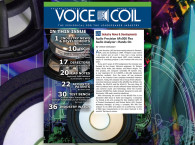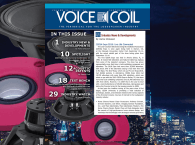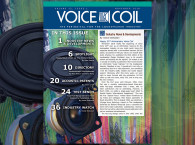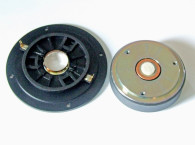 November 2019 marks the beginning of Voice Coil’s 33rd year as an information resource for the loudspeaker industry. As Vance Dickason reminds us, the idea for Voice Coil magazine started with a conversation between himself and Ed Dell (who passed away in February 2013) following the publication of the third edition of the Loudspeaker Design Cookbook (now in its 7th edition and heading for the 8th) by Dell’s company. Both shared the concept of a publication for the loudspeaker industry. Ed Dell came up with the name, Voice Coil, and as they say, the rest is history.
November 2019 marks the beginning of Voice Coil’s 33rd year as an information resource for the loudspeaker industry. As Vance Dickason reminds us, the idea for Voice Coil magazine started with a conversation between himself and Ed Dell (who passed away in February 2013) following the publication of the third edition of the Loudspeaker Design Cookbook (now in its 7th edition and heading for the 8th) by Dell’s company. Both shared the concept of a publication for the loudspeaker industry. Ed Dell came up with the name, Voice Coil, and as they say, the rest is history.
For this edition of Voice Coil, Mike Klasco (Menlo Scientific, Ltd.) focused on "Measurement Microphones: Today and Tomorrow," an article reflecting on the evolution of this indispensable tool for the industry and in particular for any loudspeaker designer. Providing an overview of the many available options in this field, and the current trends in technology, Klasco reminds us: A measurement microphone should have a flat frequency response over a wide frequency range, a low noise floor, and minimal variation in response with directionality — along with really stable characteristics that do not change with temperature, humidity, or age. Read on.
Following this overview, Nora Wong compiled another valuable updated directory of Test & Measurement Microphone manufacturers and suppliers, including related products. The directory includes suppliers with products ranging from lab-grade reference instrument microphones to hobbyist and field testing mics, and also includes ODM vendors that supply a number of the analyzer brands with precision “house brand” mics.
In Acoustic Patents, James Croft (Croft Acoustical) reviews a new loudspeaker assembly patent recently awarded to George Bullimore (Wales, Great Britain) on behalf of Tymphany. This patent basically describes a new speaker waveguide design to better support a new coaxial arrangement, with a high-frequency transducer (tweeter) nested in the center of a larger, lower frequency driver (woofer), where the waveguide features specific has cutout regions that allow "to be substantially acoustically transparent to the low-frequency sound produced by the woofer assembly.” In his review, Croft goes into detail about the evolution of this type of coaxial arrangements and compares the described new patent, looking carefully at the reasons why this initially rejected patent submission was now granted after narrowing down the inventor's claims, finally creating an effective solution for improving this established - and increasingly popular - coaxial speaker arrangement.
For this month's Test Bench, Vance Dickason looks at a professional audio and a home audio transducer, the first one from Dayton Audio and the second one from Eastech’s Punktkilde line. The first is the 3” DMA80-4, a new line array/smart speaker full-range. The second is the AUGDL0003-JN03, a 1” magnesium-lithium alloy dome tweeter.
The Dayton Audio DMA80-4 3” full-range transducer is one of the transducers from the brand's new line of full-range smart speaker/array drivers, the DMA Series. DMA stands for Dual-Magnet Aluminum Cone and includes five models of full-range drivers, all with both 8 and 4 ohm versions. All five models have pretty much the same feature set starting with a proprietary 12-spoke injection-molded frame. This frame is very open to reduce reflections back into the cone and also has a very generous mounting flange making multiple driver arrays cosmetically attractive and compact. The DMA80 cone assembly consists of a black anodized aluminum cone, with a 26 mm diameter convex aluminum dust cap (directly coupled to the voice coil former), and suspended with NBR and a 45 mm diameter treated cloth surround spider (damper) for compliance. Motive force for the cone assembly is supplied by a neodymium slug-type motor with an additional bucking magnet to focus flux into the gap area. Driving the assembly is a 1” aluminum vented (five vents below the spider mounting shelf and eight smaller vents above it) former wound with two layers of round copper wire. Other features include a large copper cap shorting ring (Faraday Shield) that lowers distortion and extends the high-frequency SPL profile. Tinsel leads connect on one side of the cone to a pair of solderable terminals.
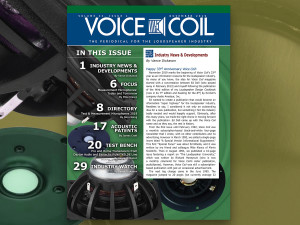 The second transducer, from Eastech’s relatively new Punktkilde line of home hi-fi drivers built in China and designed in Denmark by Scan-Speak engineers, is a tweeter from its magnesium-lithium product line, which includes this AUGDL0003-JN03 tweeter plus 4” thru 8” magnesium-lithium alloy cone woofers. Features for this transducer include a 1” magnesium-lithium foil dome diaphragm and coated cloth surround, a 79 mm × 15 mm ferrite magnet motor, a 110 mm diameter four-screw-cast aluminum faceplate anodized semi-flat black, a two-layer 25 mm diameter CCAW voice coil wound on an aluminum former, a felt damped hollow pole piece, and copper cap shorting ring (Faraday shield). The tweeter has 89 dB sensitivity and a nominal 4 ohm impedance.
The second transducer, from Eastech’s relatively new Punktkilde line of home hi-fi drivers built in China and designed in Denmark by Scan-Speak engineers, is a tweeter from its magnesium-lithium product line, which includes this AUGDL0003-JN03 tweeter plus 4” thru 8” magnesium-lithium alloy cone woofers. Features for this transducer include a 1” magnesium-lithium foil dome diaphragm and coated cloth surround, a 79 mm × 15 mm ferrite magnet motor, a 110 mm diameter four-screw-cast aluminum faceplate anodized semi-flat black, a two-layer 25 mm diameter CCAW voice coil wound on an aluminum former, a felt damped hollow pole piece, and copper cap shorting ring (Faraday shield). The tweeter has 89 dB sensitivity and a nominal 4 ohm impedance.
And as usual, Voice Coil November 2019 also includes a compilation of relevant updates in its Industry Watch section, this month also detailing new product launches from SEAS and Theory Audio.
This edition is available for download and already in the mail for print subscribers. Subscribers can go to - www.gotomyvcoil.com - to download this issue.
Remember, Voice Coil is available in print and download for all registered subscribers, free for industry professionals. To qualify for a free subscription to Voice Coil, or renew your subscription, go to: audioxpress.com/page/Voice-Coil-Subscriber-Services.html.

- on Magazine News
- News
Better Speaker Measurements with Voice Coil November 2019 Now Available
October 24 2019, 05:10
November 2019 marks Voice Coil’s 33rd year as an information resource for the loudspeaker industry. For this edition, Mike Klasco focuses on "Measurement Microphones: Today and Tomorrow," while Nora Wong provides another valuable updated directory of Test & Measurement Microphone manufacturers and suppliers. James Croft reviews a new coaxial loudspeaker assembly patent granted to Tymphany, while Vance Dickason characterizes the DMA80-4, a 3" full-range speaker from Dayton Audio, and the AUGDL0003-JN03, a 1” magnesium-lithium alloy dome tweeter from Eastech’s Punktkilde line.


